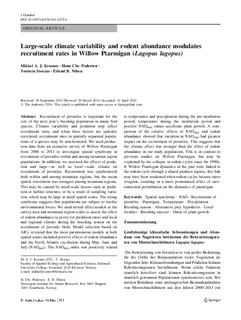Large-scale climate variability and rodent abundance modulates recruitment rates in Willow Ptarmigan (Lagopus lagopus)
Kvasnes, Mikkel Andreas Jørnsøn; Pedersen, Hans Christian; Storaas, Torstein; Nilsen, Erlend Birkeland
Journal article, Peer reviewed
Permanent lenke
http://hdl.handle.net/11250/194799Utgivelsesdato
2014Metadata
Vis full innførselSamlinger
Originalversjon
Kvasnes, M. A. J., Pedersen, H.-C., Storaas, T., & Nilsen, E. B. (2014). Large-scale climate variability and rodent abundance modulates recruitment rates in Willow Ptarmigan (Lagopus lagopus). [Vitenskapelig artikkel]. Journal of Ornithology. doi: 10.1007/s10336-014-1072-6 10.1007/s10336-014-1072-6Sammendrag
Recruitment of juveniles is important for the size of the next year’s breeding population in many bird species. Climate variability and predation may affect recruitment rates, and when these factors are spatially correlated, recruitment rates in spatially separated populations of a species may be synchronized. We used production data from an extensive survey of Willow Ptarmigan from 2000 to 2011 to investigate spatial synchrony in recruitment of juveniles within and among mountain region populations. In addition, we assessed the effects of predation and large—as well as local—scale climate on recruitment of juveniles. Recruitment was synchronized both within and among mountain regions, but the mean spatial correlation was strongest among mountain regions. This may be caused by small-scale factors such as predation or habitat structure, or be a result of sampling variation, which may be large at small spatial scales. The strong synchrony suggests that populations are subject to similar environmental forces. We used mixed effect models at the survey area and mountain region scales to assess the effect of rodent abundance (a proxy for predation rates) and local and regional climate during the breeding season on the recruitment of juvenile birds. Model selection based on AICc revealed that the most parsimonious models at both spatial scales included positive effects of rodent abundance and the North Atlantic oscillation during May, June and July (NAOMJJ). The NAOMJJ index was positively related to temperature and precipitation during the pre-incubation period; temperature during the incubation period and positive NAOMJJ values accelerate plant growth. A comparison of the relative effects of NAOMJJ and rodent abundance showed that variation in NAOMJJ had greatest impact on the recruitment of juveniles. This suggests that the climate effect was stronger than the effect of rodent abundance in our study populations. This is in contrast to previous studies on Willow Ptarmigan, but may be explained by the collapse in rodent cycles since the 1990s. If Willow Ptarmigan dynamics in the past were linked to the rodent cycle through a shared predator regime, this link may have been weakened when rodent cycles became more irregular, resulting in a more pronounced effect of environmental perturbation on the dynamics of ptarmigan.
